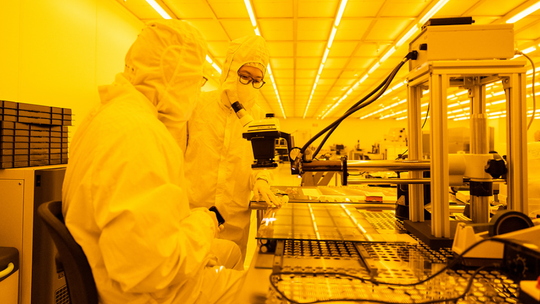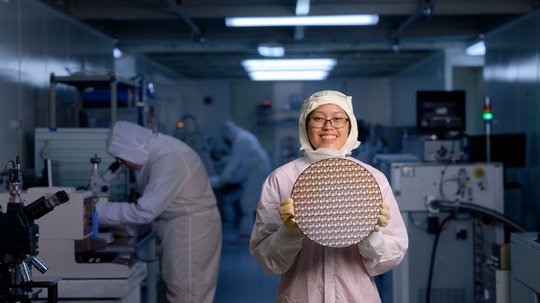
“You’re going to be building the future here in Arizona, and Arizona is building the future.”
That’s what President Joe Biden told Tilden Dickson, a sheet metal worker and Navajo Nation member, at Intel’s Ocotillo Campus in Chandler, Arizona, on March 20.
The event celebrated a newly announced preliminary agreement between Intel and the U.S. Commerce Department to provide the company up to $8.5 billion in direct funding through the CHIPS and Science Act (CHIPS Act) and up to $11 billion in loans.
In Arizona, the investment will support the construction of two new semiconductor fabs, bringing Intel’s total in the state to six, and the creation of 3,000 direct jobs.
“This will be the largest grant to any single company from the CHIPS program,” said Secretary of Commerce Gina Raimondo. “This proposed investment will help enable (Intel) to produce leading-edge chips that power our economic and national security and advanced technology – like AI.”
Arizona’s semiconductor industry is one of the fastest growing in the country. Since 2020, the state has attracted more than 35 semiconductor expansions, representing over 13,000 potential new jobs and more than $65 billion in investment – the most in the nation.*
To maximize opportunities under the CHIPS Act, Arizona, under Gov. Katie Hobbs’ leadership, has launched a collaborative effort, bringing together stakeholders from state and local governments, industry, trade groups, economic development organizations, universities and community colleges, workforce partners, and more.
These efforts have led to important new initiatives to enhance the state’s semiconductor ecosystem including new industry-led apprenticeships and workforce programs, investments in university infrastructure and research and development, training accelerators at community colleges, a national industry roadmap, and more.
“From new investments in child care to first-of-their-kind training programs and pioneering industry partnerships, Arizona has mobilized all stakeholders in the support of CHIPS Act opportunities,” said Hobbs.
Arizona already has been an early winner of the CHIPS Act. In September, the U.S. Department of Defense selected an Arizona State University-led consortium of more than 70 partners as one of eight Microelectronics Commons regional innovation hubs. The nearly $40 million award for the Southwest Advanced Prototyping (SWAP) Hub was the second-highest amount awarded and one of the first allocations of CHIPS Act funding.
In addition to the number of semiconductor companies flocking to Arizona, the state is turning heads for its variety of expansions. Arizona has attracted projects in R&D and equipment (Applied Materials, ASM, EMD Electronics, Yield Engineering Systems), materials suppliers (Edwards Vacuum, XNRGY, Sunlit Chemical, LCY Chemical, Chang Chun, NRS Logistics, Air Liquide, Fujifilm Electronic Materials, and more), manufacturing operations (Intel, TSMC), packaging and testing (Amkor) and more.
"Intel has known Arizona to be an exceptional home for semiconductor manufacturing for more than four decades,” said Zivit Katz-Tsameret, vice president of Intel foundry manufacturing and supply chain. “The ecosystem of innovation we’ve helped grow here – which includes a skilled workforce, an extensive supplier network and collaborative engagement and support from state and local government – has continued to enable Intel’s growth."
To further enhance Arizona’s semiconductor infrastructure, workforce, and research capabilities, the state has invested more than $100 million over the last year. Investments include:
- $47.5 million to ASU, enabling the Materials to Fab Center at the university’s MacroTechnology Works, in partnership with leading semiconductor innovator Applied Materials, Inc.
- $35.5 million to the University of Arizona, enabling a major expansion of the university’s Micro/Nano Fabrication Center and advancing R&D and industry partnerships.
- $13 million to Northern Arizona University to launch the Microelectronics Metrology certificate program, training center, and research laboratory.
- $4 million to establish registered apprenticeship programs for semiconductor technicians.

Arizona’s approach also includes launching pioneering new training programs, such as the Future48 Workforce Accelerator. A partnership with Maricopa Community Colleges and industry leaders like Intel and TSMC, the state-of-the-art microelectronics facility will offer a customized, industry-led training pathway for new industry entrants.
Led by the Arizona Commerce Authority, the state also launched the Arizona Small-Scale Supplier Consortium (AZ SSC), a group of private sector supply chain operators representing materials, equipment, R&D, advanced packaging, and more. The AZ SSC combined projects, which are backed by the support of more than 20 partner organizations in the state, represent nearly $1.8 billion in new investment and will create over 3,800 high-paying and high-skilled jobs in Arizona.
“With our investments in creating a state primed for investment from semiconductor companies from around the world, I know Arizona can lead the country in advanced manufacturing and technology jobs,” said Hobbs.
Learn more about Arizona’s leading semiconductor industry actions at azcommerce.com.
*According to Arizona Commerce Authority